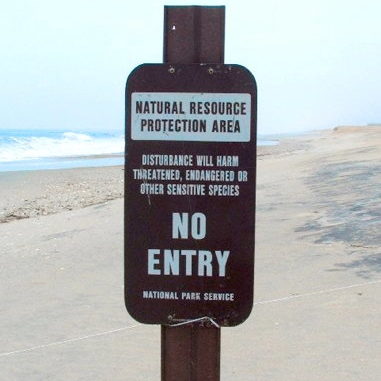
The most popular fishing spot at Cape Hatteras National Seashore, Cape Point, opened during mid July to pedestrians and opened July 29 to off-road vehicles.
The spit at Hatteras Inlet also was opened to ORVs and pedestrians during July’s third week.
All piping plover nests at Cape Point are gone. Four chicks fledged this year from seven nests at the Point. One nest at the Point was lost in a storm and another was lost to predation. Chicks from three other nests were lost to predation. At the seashore this year,11 breeding pairs of piping plovers produced seven chicks that fledged. The other three fledged chicks were at Ocracoke Island.
Unfortunately, (a) the July openings came too late to save the spring fishing season and (b) more beaches likely will be closed because sea turtle nests are reaching their hatch windows.
Ramp 44 near Cape Point reopened July 22, and pedestrian access from the ramp all the way to Cape Point was restored. About a mile of beach from Ramp 44 to an area know as the “Narrows” or the “Bypass” around the Salt Pond was opened to ORVs.
By July 30, ORV access was available to the Point but only from the east side is the Point open to pedestrians and vehicles. Colonial waterbirds and their nests and chicks are still in the area to the west of the Point. That area remains posted with signs and symbolic fencing and is closed to people on foot and to vehicles.
Hatteras Spit reopened July 24 to ORV and pedestrian access south from the end of the Pole Road on the ocean shoreline and around the tip of the spit to the area known as “The Rip” and at the sound shoreline. National Park Service officials said this area is experiencing a high rate of shoreline erosion and will be monitored daily.
The Service said it’s highly probable at mid-tide that sections of the shoreline will be impassable and may be closed for safety reasons.
Driving remains off limits at all beaches from 10 p.m. to 6 a.m.
Access to Cape Point and most of Hatteras Inlet had been closed since the first week of May, five days after a federal judge approved a consent decree that settled a lawsuit filed against the National Park Service by environmental groups over ORV access to Cape Hatteras National Seashore beaches.
While pedestrians could walk all the way to the Point, ORVs were prohibited from going past the “Bypass” area because of an American oystercatcher chick. That chick has fledged. But other beaches have started to close because the first sea turtle nests are approaching their 50-day hatch window.
Two full closures because of turtle nests began at South Beach in Frisco during the past few days that will affect access at Ramp 49.
A full beach closure became effective July 28 immediately to the east of Ramp 49, where a loggerhead nested on the side of a dune.
There is no pedestrian or ORV access around the two nests, so the South Beach is closed from Ramp 49 to the Point. For now, the beach will still be open to ORVs for the 1.2 miles to the west of Ramp 49.
A turtle nest to the west of the ramp reaches its 50-day hatch window Aug. 17. A turtle nest also could affect the newly-opened access to Cape Point in another 50 days. Currently, three turtle nests are between Ramp 44 and the Point, but they are in front of the “Bypass” at the narrow area, so the Park Service can maintain an access route behind the nests. However, a turtle nested July 21 at the north side of the bypass area, between the bypass and Ramp 44. When that nest reaches its 50-day window, a full beach closure occurs and will prohibit access to the Point until the nest hatches.
Between now and Sept. 15, the terms of the consent decree allow the Service to operate under its Interim Plan for ORV access — which means where possible the Service can allow a route behind the turtle nests.
However, beginning on Sept. 16, the terms of the consent decree dictate total beach closures from dunes to the ocean.


Be the first to comment